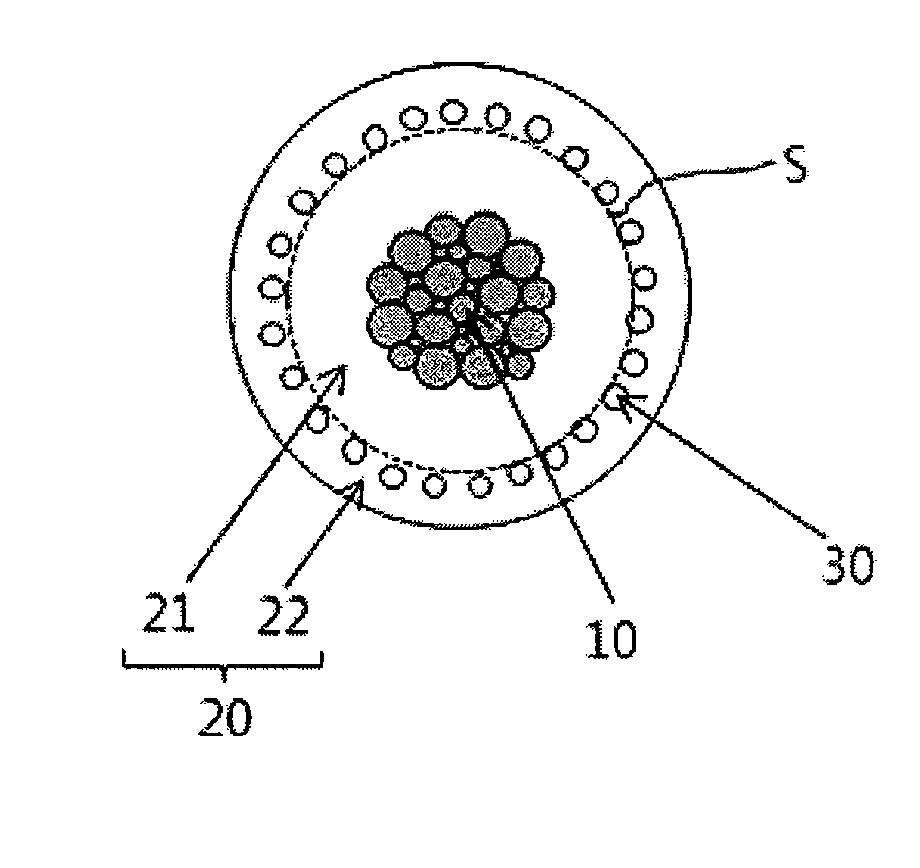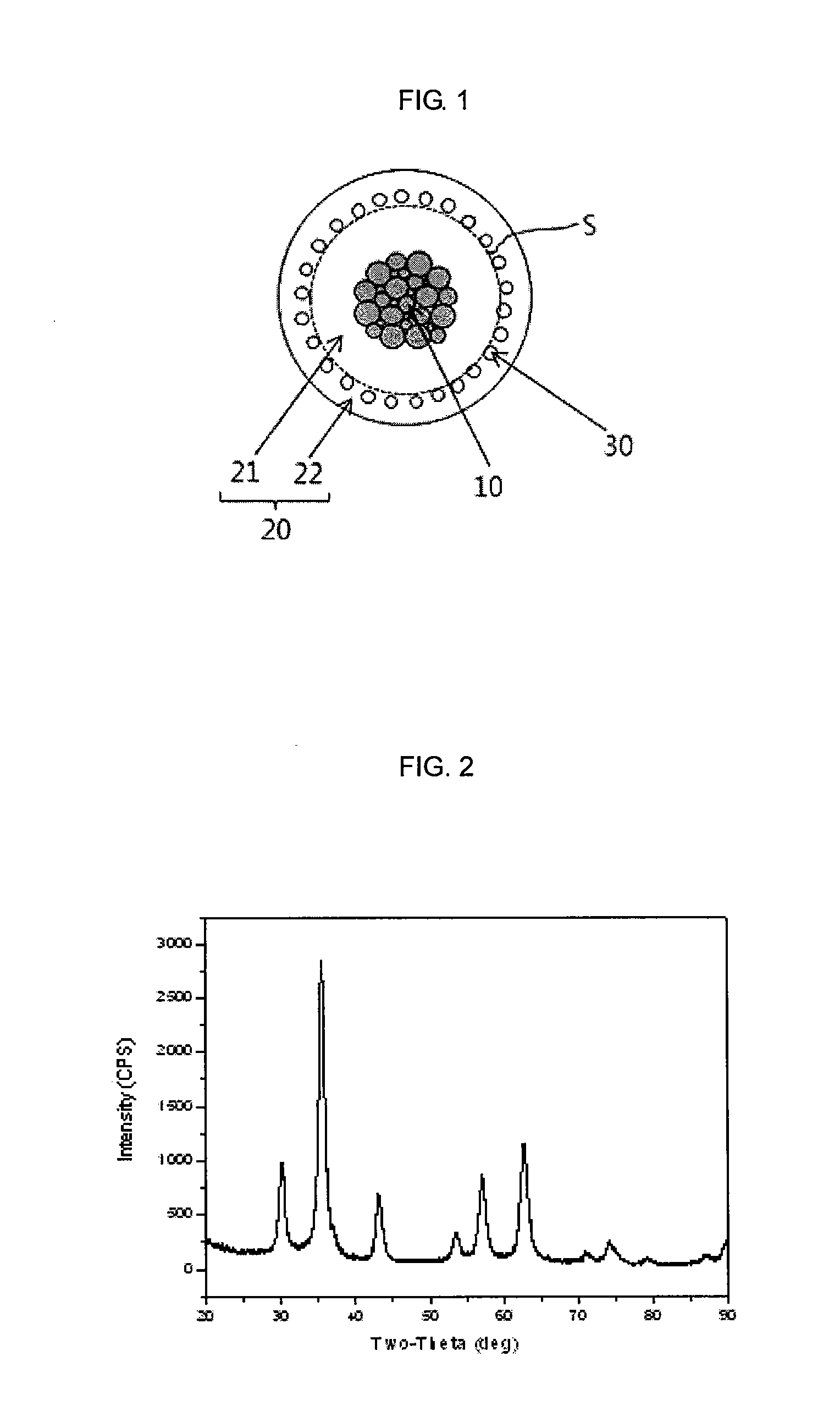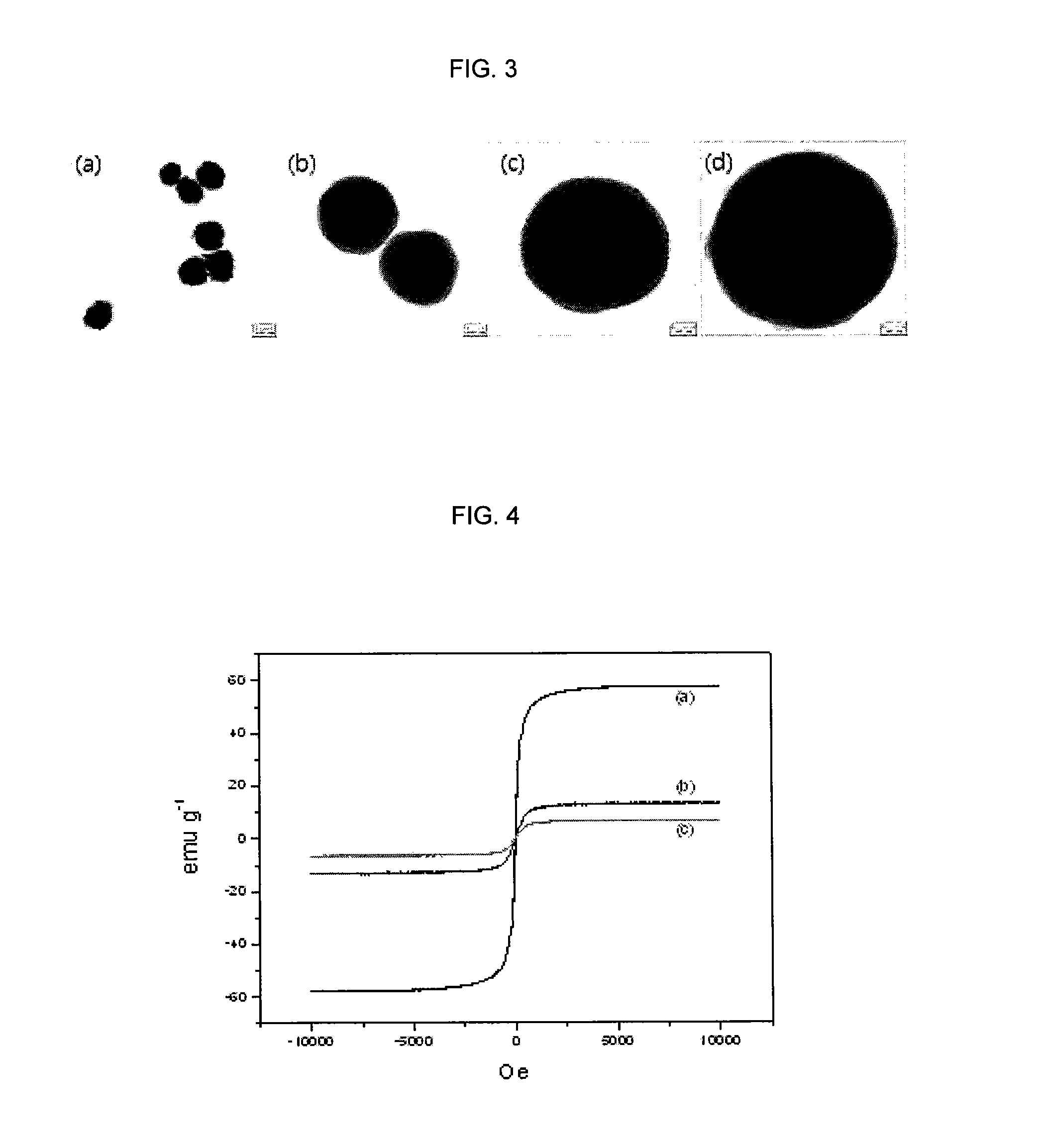Superparamagnetic cluster-nano particles-porous composite bead and fabrication method thereof
a technology of superparamagnetic nanoparticles and composite beads, which is applied in the field of superparamagnetic nanoparticles that cannot exceed, and can solve the problems of difficult to recover composite beads using magnetic fields, and the time taken to recover composite beads is long, and achieves excellent functionalities and superior dispersion properties
- Summary
- Abstract
- Description
- Claims
- Application Information
AI Technical Summary
Benefits of technology
Problems solved by technology
Method used
Image
Examples
example 1
Fabrication of Porous Composite Bead Containing Superparamagnetic Cluster (about 150 nm) and Light-Emitting Nanoparticles
[0072](1) Fabrication of Superparamagnetic Cluster
[0073]FeCl3 (0.65 g, 4.0 mmol) and trisodium citrate (0.20 g, 0.68 mmol) were melted in 20 mL of ethylene glycol, and then 1.20 g of sodium acetate was added thereto to be stirred for 30 minutes. The solution was then conveyed to an autoclave and sealed, followed by reaction in 200° C. oven for 12 hours, thereby fabricating a superparamagnetic cluster. After cooling this solution at a room temperature, the cluster was washed once with ethanol and distilled water, respectively, and attracted for recovery using a magnet. The recovered clusters were dispersed and kept in 20 mL of ethanol. This solution is referred to as ‘solution A’ hereinafter. Part of the solution A underwent XRD, TEM and magnetic hysteresis analysis, and their results were shown in FIG. 2, (a) of FIG. 3 and (a) of FIG. 4. As a result of TEM analysi...
example 2
Fabrication of Porous Composite Bead Comprising Superparamagnetic Cluster (About 340 nm) and Light-Emitting Nanoparticles
[0085]Under the same conditions to step (1) of Example 1, the amount of FeCl3 was increased to 0.975 g (6.0 mmol) to fabricate a superparamagnetic cluster of 340 nm in size, and the TEM image thereof was shown in (a) of FIG. 6. Afterwards, the processes from (2) to (6) of Example 1 were repeated to fabricate the superparamagnetic cluster-porous composite bead having the superparamagnetic cluster with the size of about 340 nm at its center, and the TEM image of the magnetic nanoparticle cluster-porous composite bead was shown in (b) of FIG. 6. Also, a superparamagnetic cluster-nanoparticles-silica porous composite bead with a final size of about 650 nm, having the superparamagnetic cluster of about 340 nm in size and having a doped quantum dot layer therein near the surface thereof was fabricated, and the TEM image thereof was shown in (c) of FIG. 6. When the magne...
example 3
Dialysis Membrane Damage Detection Using Superparamagnetic Cluster-Light-Emitting Nanoparticles-Porous Composite Bead
[0086]5 fine pores were made through a dialysis jar using a needle of 10 μm injector. The pores with the average size of 500 μm were observed by use of an optical microscope. A solution prepared by dispersing 22 mg of the superparamagnetic cluster-light-emitting nanoparticles-porous composite bead, obtained as the final product in Example 1, in 10 mL of distilled water, was poured into a dialysis jar and then placed at a beaker containing 0.5 L of water, as shown in a picture of FIG. 7. Afterwards, the water in the beaker was stirred using a magnetic bar. FIG. 7 shows comparison pictures before and after a dialysis membrane damage detection test. Examining the picture irradiating 365 nm ultraviolet rays, at the beginning, no red fluorescence of the composite bead was detected at all at the magnetic bar. However, after one day, it was clearly visible to the naked eye t...
PUM
| Property | Measurement | Unit |
|---|---|---|
| Thickness | aaaaa | aaaaa |
| Thickness | aaaaa | aaaaa |
| Thickness | aaaaa | aaaaa |
Abstract
Description
Claims
Application Information
 Login to View More
Login to View More - R&D
- Intellectual Property
- Life Sciences
- Materials
- Tech Scout
- Unparalleled Data Quality
- Higher Quality Content
- 60% Fewer Hallucinations
Browse by: Latest US Patents, China's latest patents, Technical Efficacy Thesaurus, Application Domain, Technology Topic, Popular Technical Reports.
© 2025 PatSnap. All rights reserved.Legal|Privacy policy|Modern Slavery Act Transparency Statement|Sitemap|About US| Contact US: help@patsnap.com



